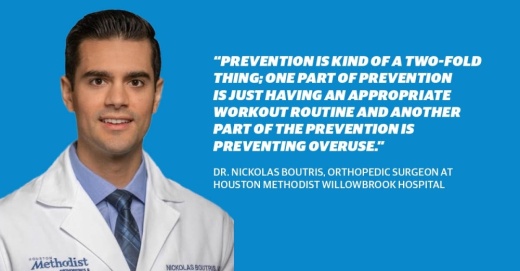With the 2021-22 school year in full swing, Community Impact Newspaper spoke with Dr. Nickolas Boutris, a Houston Methodist Willowbrook Hospital orthopedic surgeon trained in sports medicine, about how student-athletes can identify and prevent sports-related injuries this season.
He treats patients with shoulder, elbow, hip and knee injuries and said some of the most common injuries he sees include labrum, rotator cuff, ACL, meniscus and other ligament injuries.
This interview has been edited for length and clarity.
How do you identify a serious sports injury?
Identifying a serious sports injury is kind of dependent on the patient. Severe pain is typically a big red flag and then any open wounds or especially deformity. Deformity can either be swelling or a dislocation of a joint—you can see deformity or that joint just does not look right.
Other serious injuries when you’re looking at whether a player can return to a game or something like that is, can they put any weight on the extremity, can they move the injured extremity, can they move their arm to be able to throw a ball or something like that, and are they able to continue playing.
For things like head injuries or spine injuries such as concussions, we look for headaches. Headaches occur in about 70% of concussion cases; you can also have things like dizziness and light sensitivity, amnesia, mental fogginess or even more serious signs like loss of consciousness during a game. For things like spine injuries, you’re looking at [whether there is] tenderness over the spine, is there any loss of sensation in your extremities, is there any paralysis? Those will all be signs of severe injuries.
How do you prevent an injury like this from happening?
There’s actually a lot of science behind prevention. Prevention is kind of a two-fold thing; one part of prevention is just having an appropriate workout routine, and another part of the prevention is preventing overuse.
The appropriate workout routine part is more so focused on a player strengthening, appropriate stretching before exercise or actual athletic events. Then, emphasizing in preseason or offseason getting good strength and stability—focusing on neuromuscular control and proprioception exercises for balance and stability.
The other arm of it is preventing overuse; overuse is a huge issue for our athletes. [With] children and adolescents, overuse injuries make up the majority of injuries. There are over 50% of injuries that [were preventable] by either having these kids play multiple sports and not focusing on just one sport or limiting their ability to overuse it.
By having them play multiple sports, it increases all the fundamental motor skills that they need—things like strength, speed, endurance, just in general their gross motor coordination because they're playing multiple sports and having to use different parts of their body that they wouldn't use if they were just [playing one sport] alone. It leads to less injuries that way, but then it also leads to less single action like repetitive motion.





